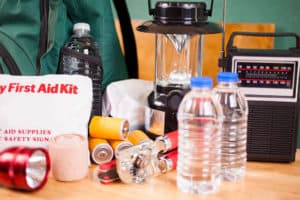Boats have many different names. You don’t need to learn them all; however, the term keel is an important one. In this article, I’ll describe what the keel of a boat is, including the full keel, fin keel, lifting keels, bilge keel, and wing keel.
What is the keel of a boat? The keel is an elongated, flat blade that extends down into the water from the bottom of the sailboat. It provides the vessel’s counterbalance, controlling the boat from being blown sideways by strong winds. It also holds the ballast, which keeps the boat right side up, preventing the boat from capsizing.
See the below image for what different types of boat keels look like:

To learn more about what the keel of a boat is and what it’s used for, read on!
In order to sail efficiently, boat owners must learn and understand how the keel interacts with the sail. It is, as you will see, as interesting and fascinating as learning how to sail.
The word “keel” originates from Old English cēol (ship’s prow), Old Norse kjóll (ship or keel), and Middle Dutch kiel (ship). Hundreds of years ago, ancient Egyptians, Greeks, Romans, and other ships sailed around the world without keels. This is, of course, possible when sailing downwind. However, they will need to row their ships in upwind situations, so they had slaves on their ships to do the rowing.
Keels can be traced as far back as the Chinese Song Dynasty in 960-1270 AD through their use of centreboards. In the same period, it was also discovered that Norwegian Vikings used keels that closely resemble the keels we use today.
What Is a Structural Keel?
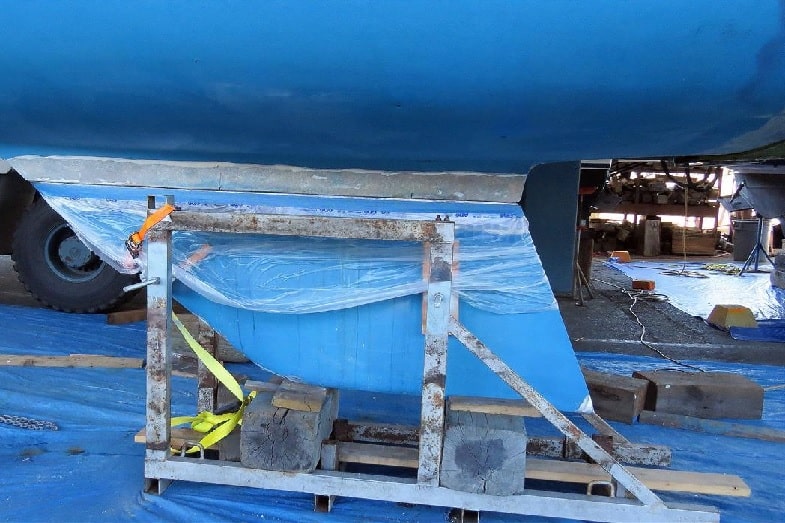
In shipbuilding, the keel is the main structural component and backbone of a ship or boat. It is usually attached at the bottom around the ship’s hull. The most common type of keel fitted in most ships and boats is the flat plate keel. It longitudinally runs along the centreline of the vessel or boat from bow to stern. The keel may also have hydrodynamic and counterbalancing purposes on some sailboats.
As the keel is the first part to be constructed, the laying down of the keel marks the date of the ship’s construction in British and American shipbuilding traditions.
Keels are made of whatever material the boat is built of, such as fiberglass, wood, or aluminum, whilst the ballast is made of lead. The keel on most traditional sailboats is built into the shape of the boat with the ballast placed beside the keel or bolted to the bottom, which is especially suitable for cruise ships. However, boats with these bolted-down keels tend to be slower.
What Is a Hydrodynamic Keel?
The forces that affect a sailboat’s movement are gravity, buoyancy, wind force that propels the boat, and the viscosity of water that slows down the boat. The hydrodynamics involved helps the boat to maintain its course. Keels generate lift whilst the boat moves forward, and the waters push against the keel.
The main purpose of hydrodynamic keels is to interact with water. It would be difficult for a sailboat to sail windward without the lift forces from the hydrodynamic keel. When the wind blows, the hydrodynamic forces create a lift that pushes the boat windward, enabling the boats to sail close to the wind.
In addition, a fixed hydrodynamic keel also has the structural strength to support the full weight of the boat.
What Is a Sailboat Keel?
Unlike most other boats like powerboats, sailboats do not require an engine to create or produce forward motion to push through the water. This is due to the combination of different parts of the sailboat, particularly the keel.
How does the keel of a sailboat work?
All sailboats have a keel, centerboard, or daggerboard. The keel serves two functions:
- First, they provide the ballast that keeps the boat from tipping over. As the boat heels over, the weight of the keel produces a force, which stabilizes the boat, turning it back into the upright position. This force, called righting moment, is stronger when the keel is heavier and deeper.
- Secondly, when a strong wind pushes the boat sideways, the keel produces the drag or force that keeps the boat from moving sideways into forward motion.
We’ll talk about the various types of sailboat keels further on but let’s discuss the important functions of the keel first.
A keel is particularly useful when you are in a “point of sail,” which does not include running. When the wind is behind you and your sailboat is in the running point of sail, a keel is redundant. However, when you are heading towards the wind, the keel is particularly useful and necessary because it helps to prevent the boat from rolling or tipping over. The hydrodynamics of both the hull and keel enable the sailboat to push through the water.
Since the keel is in a fixed position, it has a fixed shape with a large surface area. It is made of dense, heavy material, preventing the sailboat from being dragged sideways; thus, pushing the sailboat forward. Therefore, when you have a well-shaped, clean, smooth hull and keel, your sailboat will be able to move through the water easily. There’s less friction enabling more forward motion energy, which is converted to speed.
Types of Sailboat Keels
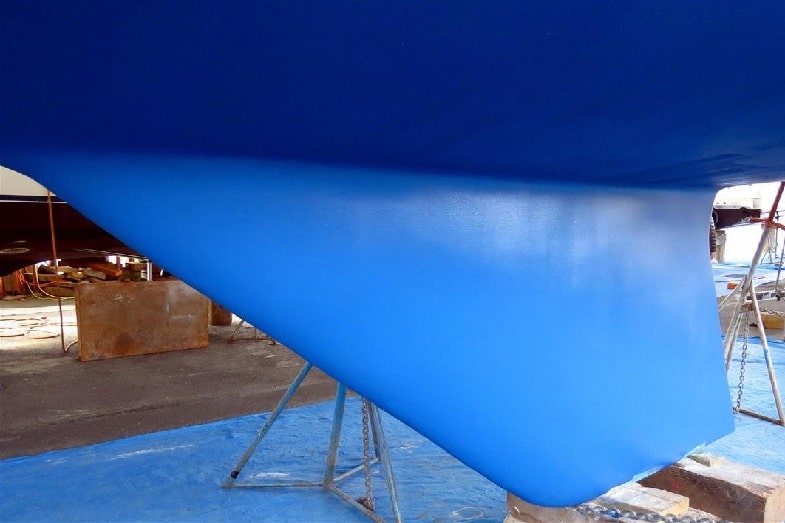
Now that we have answered the question, “What is the keel of a boat?” let’s look at the different types of keels. Choosing the right type of keel for your sailboat is, without a doubt, an important decision for you to make, as it will affect how you handle the vessel and its performance.
There are several styles of keels, such as the full keel, fin keel, lift keel, bilge, and wing/bulb keel, to name a few. There are advantages and disadvantages to each type of keel under different situations and conditions. The most common keels fitted to recreational boats are the full keel and fin keel.
1. Full Keel
The full keel or long keel is more suitable for recreational boats and is found mostly in older, traditional boats. The full keel is a narrow, V-shaped structure that extends downwards from the boat’s hull and is ballasted (weighted) for increased stability and lateral resistance. They form part of the hull structure and are extremely strong. It is also a more stable keel due to its length and weight, and it helps protects the rudder and propeller should you run aground. Moreover, it protects the rudder and propeller from debris.
In spite of its stability and strength, the full keel is slower and less efficient due to its larger surface area touching and dragging against the water. It is also more difficult to maneuver, especially when in close quarters, and slower to turn when the rudder moves.
2. Fin Keel
Most modern recreational sailboats use the smaller fin keel, which is cast in lead and bolted to the bottom or underside of the hull. The high performance and low drag fin keels resemble the wings of aircraft fighter jets. Fin keels provide ballast and are extremely efficient in preventing leeway, which is the sideways movement of the boat due to the wind. Its smaller size and airfoil shape mean there are less water resistance and higher speed, making it suitable for racing and coastal sailboats.
Fin keels are narrow–giving a short turning radius. This type of keel is excellent for short and fast tacking when you need to turn quickly. It is also easier to maneuver when berthing and moving in and out of marinas.
In addition, its low drag makes it hydrodynamically superb. Cruise yachts usually have shallow, wide fin keels and heavy bulbs to decrease the yacht’s draught. Conversely, racing yachts usually have thin, deep keels and heavy bulbs for better performance.
However, the disadvantage of a narrow fin keel means these boats are less stable and tilts relatively easily. It has less resistance against strong wind or waves, which can cause stronger and sudden heeling. With a more responsive tacking, you will also need to give extra attention to the track of your boat. The fin keel, compared to the full keel, requires you to be more alert.
3. Lifting Keels
If you want the flexibility of cruising and exploring shallow waters, the lifting keel is the answer. A lifting keel is a keel that you pull or lift, usually by a wire, rope winch, or an electric motor. Some lifting keel designs split the ballast between the ballast stub keel and the lifting centerboard. Other designs have the ballast in the keel.
A lifting keel allows the boat to remain afloat in very shallow waters by simply lifting the keel. It works in the same way as a sailing dinghy’s centerboard. When lowered, their performance is similar to that of a fixed fin keel. You might even be able to dry out on a sandy beach, although the rocks and gravel might cause damage to the hull. They are not only easier to launch and recover from slipways, but they are also easier to load and transport on trailers.
One disadvantage of the lifting keel is that mud, pebbles, and other debris lifted by the keel can get stuck in the keel box. It could damage the system and may require some maintenance. The keel cannot be dropped when there is a mechanical failure. Thus, lifting keel boats tend to be rather expensive.
4. Bilge Keel
The bilge keel, also referred to as twin keels, has a much shallower draught than fin keels. It is ideal for cruising in shallow, coastal waters without the risk of running aground. However, they do not perform to windward as well as the fin keels since they are designed more for cruising and not for racing.
Bilge keels are not installed on the centerline of the boat. Instead, the longitudinal pair of plates are attached to the sides of the hull, keeping the boat from rolling. The two keels help provide the support that keeps a boat upright when drying out at low tide. With its shallow draught and twin keel support, the bilge keel is easier to launch and recover. It also promotes easy loading and transport on trailers. Additionally, it is easy to dry out on land, remaining stable as it “sits” on the keels without needing to be propped up.
One of the disadvantages of bilge keels is the difficulty in freeing your sailboat. If you run aground and get stuck, it’s not very easy to decrease leeway (sideways slippage) underwater. It is also impossible to sail at higher speeds due to its large wetted surface.
Bilge keels are reputed to rate poorly on performance as compared to the modern fin keel. This unfavorable reputation could be in part due to the early bilge keel designs. Such designs were simple vertical flat plates with low hydrodynamic attributes. This meant that there was lower draught and resistance to leeway when the boat heels. However, bilge keel designs are now more streamlined. They are installed at an angle that leads to increased draft and better performance when sailing windward.
5. Wing or Bulb Keel
The wing or bulb keel is shaped like a wing and attached to the underside of the keel. They usually have a thick bulb placed in the center of the mid-bottom of the wing. Wing or bulb keels are more suitable for long and heavy boats.
There are, however, several advantages to using the wing or bulb keel. One main advantage of bigger boats is better forward motion due to the modified water flow. It has a smaller surface area, which makes it hydrodynamically more efficient. It promotes less friction between the keel and the water resistance or drag.
The disadvantage of the wing or bulb keel is that, like the fin keel, it has a more responsive tacking. As such, it might be more susceptible to tilting in strong wind conditions, which means you will need to be more alert at the helm.
Conclusion – What Is the Keel of a Boat?
So to recap, what is the keel of a boat? The keel is a flat blade that is at the bottom of the boat. It varies in shape from flat to long, often extending down into the water from the bottom of the sailboat. The purpose of the keel is to counterbalance the boat. It prevents the boat from tipping over sideways during strong winds.
There are different types of boat keels, including the full keel, fin keel, lifting keel, bilge keel, and wing keel. If you are in the process of buying a boat, now that you understand the keel, you’ll know it is one of the most important parts of the boat and cannot be overlooked.


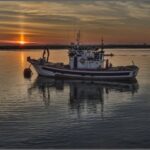

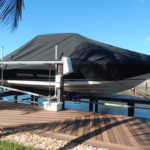

![Boat Floor Replacement Plywood [Best Options] boat floor replacement plywood](https://boatinggeeks.com/wp-content/uploads/2021/07/boat-floor-replacement-plywood-150x150.jpg)

![Read more about the article Butyl Tape [Features, Uses, How to Install, and Best Butyl Tapes]](https://boatinggeeks.com/wp-content/uploads/2021/07/butyl-tape-300x200.jpg)
